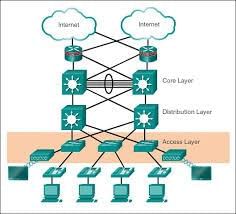Class 8 Exam > Class 8 Notes > Year 8 Computing IGCSE (Cambridge) > Networks and Digital Communication
Networks and Digital Communication | Year 8 Computing IGCSE (Cambridge) - Class 8 PDF Download
| Table of contents |

|
| Network Architectures and Topologies |

|
| Advanced Networking Protocols |

|
| Cybersecurity Principles |

|
| Internet Technologies and Cloud Computing |

|
| Safe and Responsible Online Behavior |

|
Network Architectures and Topologies
- Network Architectures: Networks are structured in different ways to facilitate communication and data exchange. Common architectures include Local Area Networks (LANs) and Wide Area Networks (WANs). LANs are used within a limited area like a school or office, while WANs connect larger geographic areas.
- Network Topologies: Topologies define how devices are interconnected within a network. Examples include star, bus, ring, and mesh topologies. Each topology has advantages and disadvantages in terms of scalability, fault tolerance, and cost.
Advanced Networking Protocols
- TCP/IP Protocol Suite: The Transmission Control Protocol/Internet Protocol (TCP/IP) is fundamental to the internet. It enables reliable data transmission and addressing across networks.
- HTTP and HTTPS: Hypertext Transfer Protocol (HTTP) and its secure version HTTPS are protocols for transmitting web pages and ensuring secure communication respectively.
- DNS (Domain Name System): DNS translates domain names into IP addresses, allowing users to access websites using human-readable names.

Question for Networks and Digital CommunicationTry yourself: Which protocol is fundamental to the internet and enables reliable data transmission and addressing across networks?View Solution
Cybersecurity Principles
- Encryption: Encryption secures data by converting it into a code that only authorized parties can access. Examples include AES (Advanced Encryption Standard) for securing data transmissions.
- Firewalls: Firewalls monitor and control incoming and outgoing network traffic based on predetermined security rules, protecting against unauthorized access.
- Phishing and Social Engineering: Techniques like phishing use deceptive emails or websites to trick users into divulging sensitive information.
Internet Technologies and Cloud Computing
- Cloud Computing: Cloud computing allows users to access computing resources over the internet, providing scalability and flexibility. Examples include Infrastructure as a Service (IaaS), Platform as a Service (PaaS), and Software as a Service (SaaS).
- Virtualization: Virtualization enables running multiple virtual machines or operating systems on a single physical machine, optimizing resource utilization.
- Web Technologies: HTML (Hypertext Markup Language), CSS (Cascading Style Sheets), and JavaScript are fundamental technologies for creating web pages and web applications.
Safe and Responsible Online Behavior
- Digital Footprint: Your digital footprint refers to the trail of data you leave online through social media, browsing history, and online interactions. Being mindful of what you share is crucial.
- Cyberbullying Awareness: Cyberbullying involves using digital platforms to harass, intimidate, or threaten others. Understanding its impact and reporting abusive behavior is essential.
- Privacy Settings: Adjusting privacy settings on social media and other platforms helps control who can access your personal information and content.
Question for Networks and Digital CommunicationTry yourself: What technology converts data into a code that only authorized parties can access?View Solution
The document Networks and Digital Communication | Year 8 Computing IGCSE (Cambridge) - Class 8 is a part of the Class 8 Course Year 8 Computing IGCSE (Cambridge).
All you need of Class 8 at this link: Class 8
|
14 videos|5 docs|6 tests
|
FAQs on Networks and Digital Communication - Year 8 Computing IGCSE (Cambridge) - Class 8
| 1. What are some common types of networks used in UK schools? |  |
Ans. Some common types of networks used in UK schools include Local Area Networks (LANs), Wide Area Networks (WANs), Virtual Private Networks (VPNs), and Wireless Networks.
| 2. How do networks help improve communication and collaboration in UK schools? |  |
Ans. Networks allow students and teachers to communicate and collaborate more effectively through email, file sharing, video conferencing, and online learning platforms.
| 3. What are some digital communication tools commonly used in UK schools? |  |
Ans. Some digital communication tools commonly used in UK schools include email, messaging apps, video conferencing platforms, online learning management systems, and social media.
| 4. How do UK schools ensure the security of their networks and digital communication systems? |  |
Ans. UK schools ensure the security of their networks and digital communication systems by implementing firewalls, antivirus software, encryption, regular software updates, and user authentication protocols.
| 5. How has the integration of digital communication technology impacted teaching and learning in UK schools? |  |
Ans. The integration of digital communication technology has transformed teaching and learning in UK schools by providing access to a wealth of educational resources, facilitating personalized learning experiences, and fostering collaboration among students and teachers.
Related Searches














